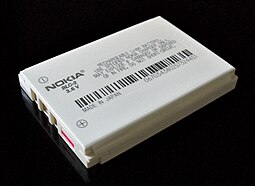Lithium-ion battery

An example of a Li-ion battery
(used in the Nokia 3310 mobile phone) |
|
| Specific energy | (0.36–0.875 MJ/kg) |
|---|---|
| Energy density | (0.90–2.43 MJ/L) |
| Specific power | ~250-~340 W/kg |
| Charge/discharge efficiency | 80–90% |
| Energy/consumer-price | 2.5 W·h/US$ |
| Self-discharge rate | 8% at 21 °C 15% at 40 °C 31% at 60 °C (per month) |
| Cycle durability |
400–1200 cycles |
| Nominal cell voltage | NMC 3.6 / 3.85 V, LiFePO4 3.2 V |
400–1200 cycles
A lithium-ion battery or Li-ion battery is a type of rechargeable battery in which lithium ions move from the negative electrode to the positive electrode during discharge and back when charging. Li-ion batteries use an intercalated lithium compound as one electrode material, compared to the metallic lithium used in a non-rechargeable lithium battery. The electrolyte, which allows for ionic movement, and the two electrodes are the constituent components of a lithium-ion battery cell.
Lithium-ion batteries are common in home electronics. They are one of the most popular types of rechargeable batteries for portable electronics, with a high energy density, tiny memory effect and low self-discharge. Beyond consumer electronics, LIBs are also growing in popularity for military, battery electric vehicle and aerospace applications. For example, lithium-ion batteries are becoming a common replacement for the lead–acid batteries that have been used historically for golf carts and utility vehicles. Instead of heavy lead plates and acid electrolyte, the trend is to use lightweight lithium-ion battery packs that can provide the same voltage as lead-acid batteries, so no modification to the vehicle's drive system is required.
...
Wikipedia
